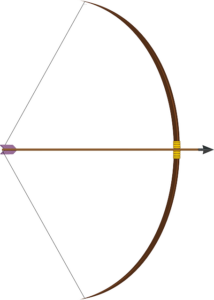The body possesses mechanical energy is due to both potential and kinetic energy. Conversion of potential energy into mechanical thus involves the transformation into kinetic or potential energy.
Some example of potential energy to mechanical energy listed below:
- Water turbines
- Solar cell
- Firearm
- Fossils
- Ignition of gasoline
- Nuclear power plant
- Motor runs on battery
- Stretching an arrow
- Fixing nail on the wall
- Roller coaster ride
- Steam engines
- Wrecking ball
- Dart gun
- Bowling ball
- Cycling
Water turbines
Water turbines are used to generate hydroelectricity from the falling water—the water before falling stores a lot of potential energy. As the water from the enormous height falls on the turbine, the turbine begins to rotate, generating electricity. Thus, in hydroelectricity generation, the potential energy of the water is transformed and exert a force on the turbine to do work in the form of mechanical energy.
Solar cell
Solar cell stores the irradiated sunlight in the battery as charges possessing potential energy. When fitted to the light bulb, this solar cell converts its potential energy into mechanical energy by making the bulb glow. The solar cell works with the same principle in water heaters.
Firearm
The bullet inside the firearm possesses a lot of potential energy before triggering. Once the gun is triggered, the bullet loses the potential energy and gains kinetic energy to be left out of the gun. In this case, the potential energy is converted into mechanical energy by triggering the firearm, thus making the bullet attain kinetic energy.
Fossils
Fossils are the left impression of dead animals’ bones, skeleton microbes, stones, hair, oil, or wood embedded in the rock as a petrified form. The fossils store potential energy, which can be utilized further to do mechanical work.
Fossils are extracted to use as fuels. When the fossils are burned, they produce heat used to run the motor. Thus fossil is an excellent example of potential energy to mechanical energy.
Ignition of gasoline
Before the ignition of gasoline in automobiles, it stores the chemical potential energy in it. Once the gasoline ignited, the stored potential energy is transformed to the piston in the form of heat, which drives the piston to do the work.
The internal combustion of the gasoline thus converts the potential energy into mechanical energy in the piston by making the wheel rotate, causing the motion of the automobile to possess kinetic energy.
Nuclear power plant
The nuclear power plant generates electricity using radioactive atoms such as uranium atom as the fissionable element. Initially, the uranium atom stores the potential energy in it.
The uranium atom undergoes nuclear fission in the reactor core by generating heat, thus making the water boil and steam is produced. The steam pressurizes the blade and makes the turbine rotate. As the rotation speed increases, electricity is produced. Thus potential energy in the uranium atom is converted into mechanical energy of the turbine.
Motor runs with battery.
Any motor which runs on the battery is an excellent example of potential energy to mechanical energy as the battery stores the charges in the form of potential energy. When the battery is turned on, the charges flow to do the work; thus, the motor runs. The motion of the motor is due to the conversion of potential energy into mechanical energy.
Stretching an arrow
The arrow and bow both possess potential energy due to the virtue of their position. When the bow is stretched then left, the potential energy is transformed, and thus the arrow gains the kinetic energy. Thus, stretching causes the arrow to convert potential energy to mechanical energy.

Fixing nail on the wall
Fixing the nail on the wall with the help of a hammer possesses a kind of mechanical energy. By hitting with a hammer, the nail drives into the wall. Before hitting, both hammer and nail possess potential energy due to virtue of their position.
When we swing the hammer from some distance before it can hit the nail, the potential energy of the hammer is lost, and it gains kinetic energy. Thus mechanical energy came into existence in fixing the nail as the combination of potential energy, and kinetic energy is termed as mechanical energy.

Roller coaster ride
A Roller coaster possesses both potential energy and kinetic energy. At the top of the track, the coaster contains potential energy before the ride begins. Once the coaster begins to move, the potential energy is transformed. The transformation of potential energy is responsible for the coaster to do work.
Steam engines
The steam engines are capable of doing work only when the coal is burnt to form the steam by boiling the water. Before burning, coal stores enormous amount of potential energy. As the coal is burnt and water gets boiled, the steam is produced, which pressurizes the piston to do the mechanical work, thus causing the motion.
Wrecking ball
The wrecking ball is a large round structure hung with the help of a chain or string used for demolition buildings. The large ball is held at a certain height with the help of a crane. At that instance, the ball possesses potential energy. As soon as the ball is dropped, it acquires kinetic energy; thus, by hitting building collapses. The force of application to collapse is the form of mechanical energy.

Dart gun
A dart gun is fitted with a spring that possesses elastic potential energy. When the gun is loaded, the spring compresses. Due to compression, the spring applies the force on the dart to move out of the spring. This force is termed mechanical energy as the dart gun does the work due to this force.
Bowling ball
A targeting game that illustrates the mechanical energy by both potential and kinetic energy is the bowling ball. The ball and target pins used in the bowling ball have potential energy. When the ball rolls towards the pin and hits them, the pin displaces from their position; thus, work is done. The force applied to the pin to expel its position is due to the ball’s potential energy converted into mechanical energy.
Cycling
The best example of potential energy to mechanical energy conversion is cycling. The nutrients in our body possess potential energy, which converts into potential energy whenever we need to do work. While cycling, the potential energy in the body is transferred to the pedal to do work; hence, mechanical energy comes into play in cycling.
Also Read:
- Example of potential energy to thermal energy
- How to utilize nuclear energy in space exploration
- How to calculate the kinetic energy of a satellite re entering earth s atmosphere
- How to find net energy
- How to optimize nuclear energy generation in a fusion reactor
- Why does energy play a role in topological insulators
- Example of radiant energy to kinetic energy
- Types of solar energy
- Can potential energy be created
- Example of chemical energy to electrical energy
I am Keerthi K Murthy, I have completed post graduation in Physics, with the specialization in the field of solid state physics. I have always consider physics as a fundamental subject which is connected to our daily life. Being a science student I enjoy exploring new things in physics. As a writer my goal is to reach the readers with the simplified manner through my articles.
